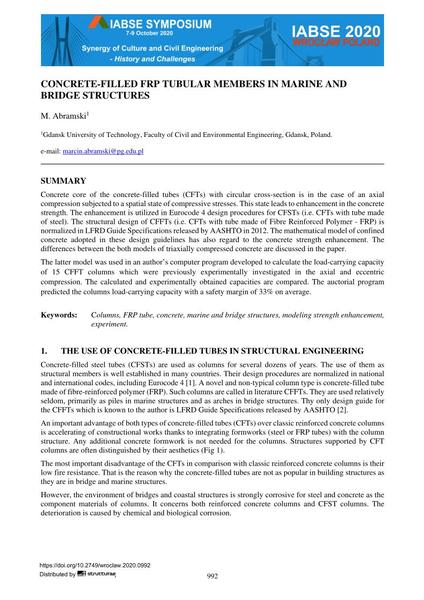Concrete-Filled FRP Tubular Members in Marine and Bridge Structures

|
|
|||||||||||
Bibliographic Details
| Author(s): |
M. Abramski
|
||||
|---|---|---|---|---|---|
| Medium: | conference paper | ||||
| Language(s): | English | ||||
| Conference: | IABSE Symposium: Synergy of Culture and Civil Engineering – History and Challenges, Wrocław, Poland, 7-9 October 2020 | ||||
| Published in: | IABSE Symposium Wroclaw 2020 | ||||
|
|||||
| Page(s): | 992-999 | ||||
| Total no. of pages: | 8 | ||||
| Year: | 2020 | ||||
| DOI: | 10.2749/wroclaw.2020.0992 | ||||
| Abstract: |
Concrete core of the concrete-filled tubes (CFTs) with circular cross-section is in the case of an axial compression subjected to a spatial state of compressive stresses. This state leads to enhancement in the concrete strength. The enhancement is utilized in Eurocode 4 design procedures for CFSTs (i.e. CFTs with tube made of steel). The structural design of CFFTs (i.e. CFTs with tube made of Fibre Reinforced Polymer - FRP) is normalized in LFRD Guide Specifications released by AASHTO in 2012. The mathematical model of confined concrete adopted in these design guidelines has also regard to the concrete strength enhancement. The differences between the both models of triaxially compressed concrete are discussed in the paper. The latter model was used in an author’s computer program developed to calculate the load-carrying capacity of 15 CFFT columns which were previously experimentally investigated in the axial and eccentric compression. The calculated and experimentally obtained capacities are compared. The auctorial program predicted the columns load-carrying capacity with a safety margin of 33% on average. |
||||
| Keywords: |
concrete columns experiment FRP tube marine and bridge structures modeling strength enhancement
|
||||
